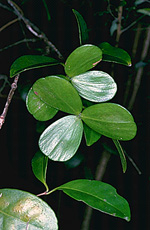 |
This small family is widely distributed in tropical and warm-subtropical regions of the world. In Australia, a few species occur in rainforests and vine scrubs, sometimes close to mangroves, in the Top End of the Northern Territory and through eastern Queensland to northern New South Wales.
Characteristic features of the family Hippocrateaceae in Australia include: - woody lianes or scandent shrubs, often climbing by knotted branchlets
- leaves simple, opposite or nearly so
- flowers small, bisexual, with a 5-lobed or irregularly splitting calyx and usually 5 free petals
- stamens 2 or 3 (rarely 4), the anthers opening by transverse splits
- ovary superior but usually partially immersed in a prominent nectary-disc
- fruits either dry, orange to red drupes or a prominently 3-lobed capsule with strongly flattened lobes
Description
Evergreen shrubs, or woody or herbaceous vines climbing by twining stems or scrambling. Internal secretions not obvious. Plants glabrous or with simple, non-glandular, uniseriate hairs. Leaves opposite, petiolate. Stipules distinct and free from the petiole, scale-like or membranous, falling off early or persistent. Lamina simple, symmetric, lanceolate, ovate, elliptic, oblanceolate, obovate or oblong; base cuneate or attenuate; margins entire, crenate or serrate, ±flat, revolute or recurved; venation pinnate, with the midrib conspicuous, and the tertiary venation not reticulate; surfaces not punctate; leathery. All the flowers bisexual. Inflorescences axillary, consisting of panicles, umbels, dichasial or monochasial cymes. Bracts and bracteoles present. Flowers ?odourless; stalked. Floral disc present; nectaries ?absent. Perianth of 2 dissimilar whorls. Calyptra present or absent. Calyx regular or irregular; segments fused, with 2–3 or 5 lobes, imbricate in bud; calyx cup-shaped, herbaceous. Corolla regular; segments free, with (4–) 5 (–7) petals, alternating with the calyx lobes, imbricate or valvate in bud, cream, without contrasting markings, membranous or papery; claws absent; lobes ±entire. Fertile stamens (2–) 3, not clearly correlated with the calyx lobes, free of the corolla, free of the ovary and style, distinct from each other, all ±equal. Anthers basifixed, not versatile, opening outwards by transverse slits, 2-celled. Ovary superior and sessile. Carpels 2–5, fused; ovary with 2–3 locules. Style terminal, single and unbranched and the stigma truncate. Ovules 2–15 per locule, stalked; placentation axile. Fruit fleshy, dehiscent or indehiscent, a loculicidal capsule, berry or drupe; the perianth on the maturing fruit deciduous or dry and persistent. Disseminule macro-surface featureless or winged; micro-surface ±smooth, orange, red, green or brown, dull. Seeds 1–30 per fruit. Aril absent. Cotyledons 2. Embryo straight.
(Note: this description has been generated from the coded data compiled for the key. Any errors in the key data will be reflected in the descriptions.)
A treatment of the family Hippocrateaceae has been published in:
Flora of Australia 22: 180-181.
Australian genera of Hippocrateaceae (as recognised for the Flora of Australia)
Hippocratea
Loeseneriella
Salacia

|
  |

Hippocratea barbata (fruits)
Photo: M.Fagg © M.Fagg
|
 |
|